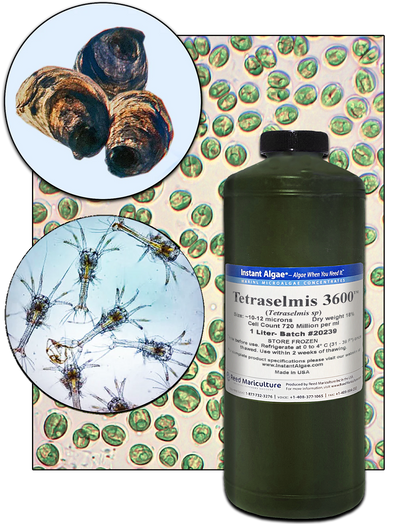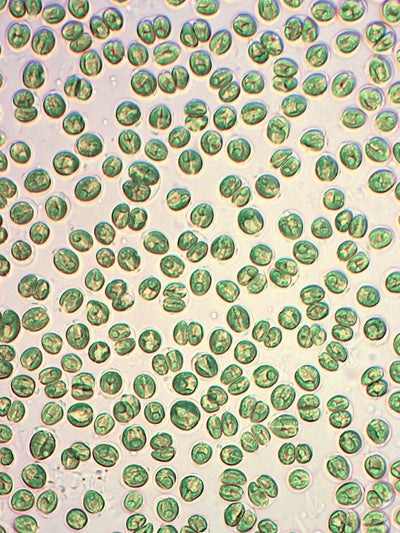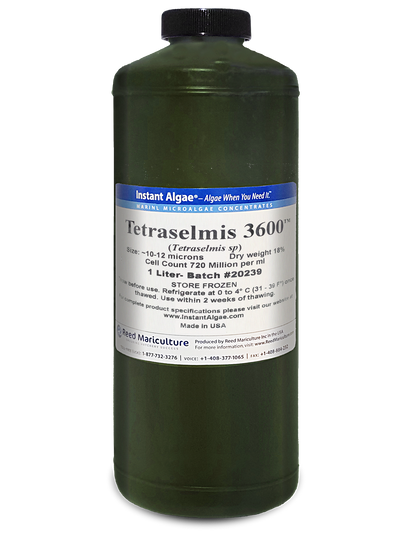


TET 3600™
Tet 3600™ is a frozen, whole-cell concentrate of Tetraselmis, a large green flagellate with a very high lipid level and natural amino acids that stimulate feeding in bivalves and larval shrimp.
Product Description
Applications & Benefits
Directions & Feeding
Directions
- Defrost overnight in a refrigerator.
- When water is circulated with a centrifugal pump, such as with an upweller, add in front of the pump intake and the pump will disperse the algae cells.
- When feeding into open tanks or header tanks, pre-dilute the algae 10:1 with system water.
- Add system water to a small bucket.
- Add TET 3600 and stir.
- DO NOT BLEND; it is unnecessary and may damage the algae cells.
- Pour into larvae tank or spat.
- Pouring through a 20–micron screen can improve dispersion.
- Feed according to the table below. Adjust dosage to meet the needs of your hatchery and larvae.
- Refrigerate bottle when not in use.
- Use within 7 days of defrosting
Typical Feeding Ration
Larvae
Feed according to shell length. Shell length on a given day is an estimate. Larviculture may run up to 20 days.
Daily Feed Rates per million larvae, for Crassostrea virginica (from FAO protocol)
| Day | Mean shell length | TET 3600 (ml) | Liters of live Isochrysis (4x10^6 cells/ml) |
|
|---|---|---|---|---|
| 2 | 75 | N/A | = | N/A |
| 3 | 95 | N/A | = | N/A |
| 4 | 100 | N/A | = | N/A |
| 5 | 115 | N/A | = | N/A |
| 6 | 130 | N/A | = | N/A |
| 7 | 145 | 2.4 | = | 5.1 |
| 8 | 160 | 3.1 | = | 6.6 |
| 9 | 190 | 4.4 | = | 9.5 |
| 10 | 220 | 5.8 | = | 12.4 |
| 11 | 240 | 6.7 | = | 14.4 |
| 12 | 260 | 7.6 | = | 16.3 |
| 13 | 270 | 8.1 | = | 17.3 |
| 14 | 280 | 8.5 | = | 18.3 |
Spat
Feed By Live Weight
- 0.5ml TET 3600 per gram live weight of spat per day
- Works for all sizes of spat
– OR –
Feed by Seed Count and Size
(Feeding 1 million Oyster Spat; based on FAO manual, p. 137, Table 14)
| Length (mm) | TET 3600 feed per day |
|---|---|
| 0.3 | 3.1 ml |
| 0.5 | 23 ml |
| 1.0 | 95 ml |
| 2.0 | 0.7 Liters |
| 3.0 | 2.2 Liters |
Feeding Broodstock Conditioning and Fattening
Typical Broodstock Feed Rates:
0.015–0.027 ml TET 3600 per gram wet meat weight per day
-OR-
0.15–0.5 ml TET 3600 per adult animal per day (depending on feed ration and size*)
*The required food ration for conditioning is based on the meat weight of the adults. It is usually between 2 and 4% of the mean dry meat in dry weight of algae fed per day. This is approximately equivalent to 0.015–0.027 ml TET 3600 per gram of wet meat weight.
Storage & Technical Data
| Packaging | 1-liter bottle |
|---|---|
| Storage | 2-year shelf life when frozen use within 1 week of defrosting |
| Tip | Keep frozen before defrosting, refrigerate after defrosting. |
| Physical Properties | |
|---|---|
| Description | Viscous green-brown concentrate |
| Algal size | 10–20 microns |
| Cell Density | ~0.72 Billion cells per ml |
| Microalgal Biomass (Dry) | 180g Biomass/L |
| Composition of Dry Algal Biomass (Typical) | |
|---|---|
| Protein | 54.5% |
| Lipids | 14.2% |
| Carbohydrate | 18.0% |
| Ash | 12% |
| Composition of Liquid Product | |
|---|---|
| Protein | > 9.8% |
| Lipids | > 2.5% |
| Carbohydrate | > 3.2% |
| Ash | < 10.0% |
| Moisture | < 81% |
| Microbial Specification | |
|---|---|
| Coliform bacteria | 2 <0.3 mpn/mL |
| Salmonella3 | Negative |
| Known pathogenic marine bacteria |
Negative |
Customer Reviews
Related products

LPB™ FROZEN SHELLFISH DIET®
For Larvae, Post-larvae and Broodstock Bivalves and Larval Shrimp, LPB is a frozen, whole-cell concentrate of Tetraselmis sp., Thalassiosira weissflogii, Thalassiosira pseudonana, and Schizochytrium

SHELLFISH DIET 1800®
A unique mix of five marine microalgae - Isochrysis, Pavlova, Tetraselmis, Thalassiosira weissflogii and Thalassiosira pseudonana species that have demonstrated success with a wide variety of marine and freshwater shellfish, including: oysters, clams, mussels, scallops, and crustaceans.

